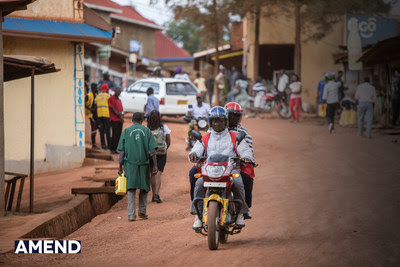SHARM EL SHEIKH, 16 November 2022 – UNICEF is launching a new climate financing initiative to enhance countries’ climate resilience and disaster preparedness for children and youth and bolster protection for children from the impacts of future climate-related disasters.
The Today and Tomorrow initiative is an integrated climate change finance solution that, for the first time, combines funding for immediate climate resilience and risk prevention programmes for children today, with an innovative use of risk transfer finance provided by the insurance market for cyclone disasters tomorrow. The combined financing platform is designed to help countries address the current and growing impacts of the climate crisis while preparing for future emergencies and rapidly responding to them when they occur.
“The risks of climate change are no longer hypothetical. They are here. And even while we work to build communities’ resilience against climate disasters, we have to become much better in pre-empting risks for our children,” said Karin Hulshof, UNICEF Deputy Executive Director for Partnerships. “We know more climate disasters are in the making. We just do not know where or when they will hit.”
Children and youth are a critically vulnerable population group that is among the most affected by disaster risk and climate change, including the effects of extreme weather events such as cyclones. Last year, UNICEF’s Children’s Climate Risk Index estimated 400 million children (nearly 1 in 6 children globally) are currently highly exposed to cyclones.
In its initial three-year pilot, UNICEF’s Today and Tomorrow will focus on eight countries in four global cyclone basins – Bangladesh, Comoros, Haiti, Fiji, Madagascar, Mozambique, Solomon Islands, and Vanuatu. To take this effort forward, UNICEF is raising $30 million for the initiative and is calling for additional private and public partners to take action and join UNICEF in helping to close the intensifying humanitarian financing gap for disaster protection for children and youth.
Climate harm in childhood lasts for life and perpetuates and deepens inequality and poverty across generations. However, the unique needs of children are not directly addressed by existing Risk Transfer mechanisms. This leaves a global humanitarian financing gap, or ”Child Protection Gap”, that encompasses hundreds of millions of children and youth.
UNICEF’s Today and Tomorrow is the first pre-arranged and event-based climate disaster risk financing mechanism that specifically targets this Child Protection Gap, with full support for the Tomorrow portion of the risk transfer instrument, secured from the German and UK governments under the newly launched G7-V20 Global Shield against Climate Risks.
“We are pleased to support UNICEF in advancing the world’s first child-centred financial protection tool for climate-related hazards and show the new G7/V20 Global Shield Against Climate Risks at work,” said Heike Henn, a Director at the German Ministry for Economic Cooperation and Development (BMZ). “We expect that UNICEF’s Today and Tomorrow Initiative will deliver in three areas: first, increased uptake of ex-ante risk financing solutions by governments through knowledge sharing and increased familiarity with risk financing instruments; second, improved institutional and operational shock resilience of development institutions, and third and most importantly, closing the disaster risk protection gap for the most vulnerable people, especially children and mothers.”
“The UK is proud to be a partner in the new Global Shield against climate and disaster risks, and to co-fund the Global Shield Finance Facility,” said Rt. Hon. Andrew Mitchell, Minister of State in the UK’s Foreign, Commonwealth & Development Office. “We strongly support bringing pre-arranged and trigger-based financing to the humanitarian sector, and I’m delighted that the Facility will expand its work as part of the Shield, including this new grant to UNICEF to enable them to protect up to 15 million children, young people and their families across Africa, the Caribbean, Asia and the Pacific and respond rapidly if tropical cyclones hit.”
Cyclones and the disasters they trigger, such as floods and landslides, represent the fastest-growing category of climate-influenced disasters and are a major cause of losses and damages worldwide. UNICEF’s research has shown that investments that reduce exposure to and negative impacts from cyclones and other hazards can considerably reduce overall climate risk for millions of children.
“UNICEF is the first UN institution, as well as one of the largest humanitarian organisations worldwide, to take out a bespoke disaster risk coverage for the protection of children, youth and parents, especially mothers,” said Simon Young, a Senior Director in the Climate and Resilience Hub at WTW, the advisory that designed the insurance solution. “As such, UNICEF is pioneering proof of concept for other organisations in the field. The decisive action by UNICEF can be a catalyst for more efficient, reliable, and quicker humanitarian crisis finance.”
As well as pressing governments and big businesses to rapidly reduce emissions, UNICEF urges leaders to take immediate action to protect children from climate devastation by adapting the critical social services they rely on. UNICEF also urges parties to find and fund solutions to support those who will face climate losses and damages beyond the limits to which communities can adapt.
Source: UN Children’s Fund

